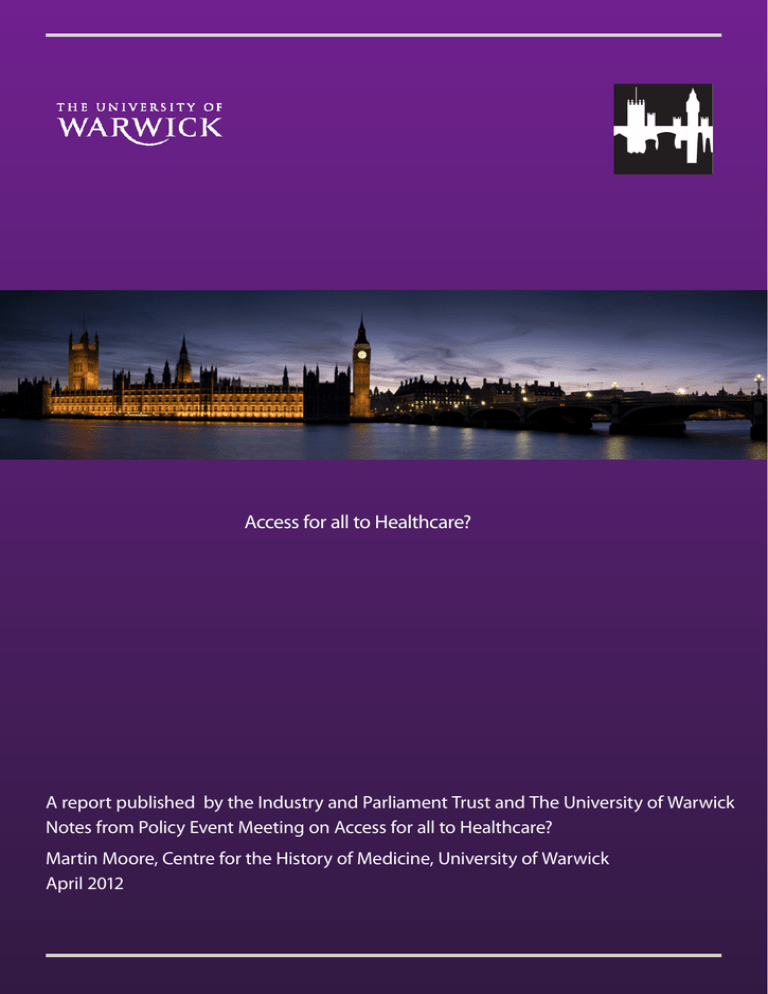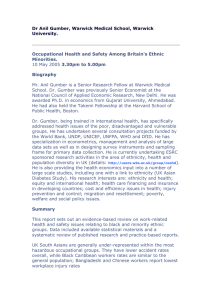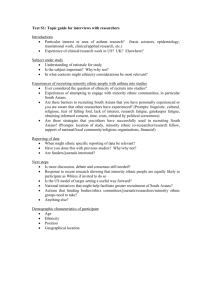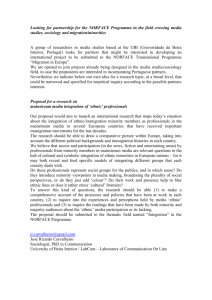Access for all to Healthcare?
advertisement

Access for all to Healthcare? A report published by the Industry and Parliament Trust and The University of Warwick Notes from Policy Event Meeting on Access for all to Healthcare? Martin Moore, Centre for the History of Medicine, University of Warwick April 2012 Access for all to Healthcare? INTRODUCTION The evening opened with an overview of two historical case studies: the first the 1980-1982 “Stop Rickets” campaign, and the second the struggles of Cypriot and African-Caribbean communities to ensure they had access to sickle-cell and thalassaemia screening in the 1970s. In both instances effective interventions were slowly implemented, but only because the causes were invested with time, resources and genuine two-way discussion between ethnic minority communities and senior government officials. The production process was not smooth, particularly in the case of sickle cell and thalassaemia, due to the assumptions that Ministers and Civil Servants made about the needs and motivations of the minority communities in question. Nevertheless, once the affected communities had managed to convince doctors, politicians and their international contacts that interventions were required, successful public health programmes were put in place. The rest of the meeting centred on the 4 key themes raised by this historical research: targeting the social determinants of health, the relative impacts of poverty and cultural differences in differential health outcomes, the fundamentals of successful public health interventions and the necessity for integrated services. 03 04 www.ipt.org.uk/ TARGETING THE SOCIAL DETERMINANTS OF HEALTH Attendees discussed the need to redirect attention towards social rather than biological explanations for differences in ethnic health outcomes. Some members suggested that genes contributed to – though did not determine – the disproportionate impact of certain conditions on particular ethnic minority groups, for instance, mental health issues amongst African-Caribbean migrants. Other members countered this, however, suggesting that genetic differences are by no means restricted to ethnic groupings. They continued by arguing that, in any case, the best evidence available indicates social determinants of health are overwhelmingly the most important factors in influencing morbidity and mortality distribution. For migrants in particular, both the experience of migration and the cultural assumptions made by the majority population significantly impacted their ability to access healthcare. It was agreed that in light of this evidence, political and financial attention needed to be directed away from interrogating biological explanations and towards uncovering the social determinants for health inequalities. POVERTY VS CULTURAL DIFFERENCES From here members turned their focus towards questions of the root causes of health inequalities. Almost all discussants highlighted poverty as a significant issue in the differential health outcomes experienced by ethnic minority groups. Attendees pointed out that ethnic minority groups were disproportionately represented within lower income groups, a situation structurally perpetuated across generations. However, there was disagreement over the extent to which ethnic minorities suffered from exactly the same problems as the majority population. Some members intimated that as incomes rose and as access to services was improved for all, the problems suffered within ethnic minority populations would self-correct. Other discussants disagreed, suggesting that localised cultural differences – either assumed by practitioners, or real-but-ignored – were still influential in structuring health inequalities. Research into cancer screening was mentioned in light of this, work that was dependant on economic factors and still found ethnic differences in health. Such work, these members argued, meant that more focused approaches would be needed in each region and for each population. For instance, pamphlets advising on life-style changes or on self-examination in certain conditions were condemned as often being inappropriate for non-English speakers, or those rendered illiterate due to structural inequalities in educational services. Similarly, these contributors argued that so long as service providers made assumptions about the medical needs of ethnic community groups (often equating their requirements with those of the majority population) ethnic minorities would continue to suffer unequal health outcomes. One member referred back to the sickle-cell example previously outlined as a case in which the recognition of different needs resulted in a variegated and effective approach to health provision. Access for all to Healthcare? THE FUNDAMENTALS FOR EFFECTIVE PUBLIC HEALTH INTERVENTIONS The majority of the meeting was spent discussing what made previously effective health campaigns in issues of ethnic health successful. The opening remarks had placed a strong emphasis on the ability to learn from ethnic minority communities. In almost all constituencies, ethnic minorities ate considerably more fruit and vegetables than the majority population and generally consumed less fat. Whilst this picture was changing with the assimilation and integration of second and third generations, minority communities still represented a wealth of knowledge on how to address the major health concerns facing all British citizens. Building on this, there was a strong consensus that having enthusiastic service providers and medical professionals with cultural awareness of their diverse populations was integral to successful interventions. Members highlighted numerous examples of minority groups in various parts of the country, where ignorance and either implicit or explicit stigma has resulted in shocking instances of health inequality. One contributor referred to Roma communities who suffered four times the number of infant deaths compared to the majority population as a case in point. To this end, members debated the need to have ethnic minority candidates on the new clinical commissioning groups. Whilst some discussants suggested that 40 per cent of doctors were now from ethnic minority backgrounds, others were still concerned by the lack of ethnic minority practitioners and managers at board level. Referring to both the case studies outlined and other historical experiences, such as HIV/AIDs, other members added that local and national politicians were also key members in the public health machine. In all the examples mentioned, these members argued, the difference between services getting off the ground and being marginalized was political will. Other discussants proposed that MPs and members of the House of Lords in particular were important here. These contributors stated that such speakers had a voice in areas where academic experts and community activists did not. By raising their voice on the floor of each House, it was noted, these MPs could force significant health issues onto the political agenda and gain valuable answers from Civil Servants on problems that would otherwise have remained invisible. Indeed, a another member pointed out that in the rickets, AIDs and sickle cell – thalessaemia examples, a strong, top-down input from central government was vital. Nevertheless, as all members agreed, these interventions could only be effective, like all medical campaigns, by ensuring the communities affected were fully involved in planning and organising service delivery. Discussants proposed that only by, for instance, asking local minority populations what they felt their needs were, when they could attend clinics, who they wanted to see and where they wanted to see them, could effective interventions be planned and enabled. Further, it was added that this engagement needed to be long-term. Too much planning has been based on one-off or short-term exchanges meaning that previously successful provisions have become less effective as demographics and cultural institutions have changed over time. 05 06 www.ipt.org.uk/ Attendees also suggested that financial as much as political will would be important in all interventions. A number of examples were referred to where funding for successful interventions was not forthcoming after pilot grants disappeared. For instance, an award-winning primary care service for unaccompanied, asylumseeking minors (aged 10-18) was closed after its funding was not renewed. Similarly, members indicated that community consultation costs money and requires an investment of time; fears were raised that this would be one of the first areas to disintegrate under the new regime of reorganization and cuts. According to some contributors though, the media had been under-utilized as a means to ensure that both this financial and political capital remained in place. Television in particular, they argued, was an incredibly powerful medium through which to convince politicans, the medical professions and ethnic minority publics that certain conditions need addressing. It was suggested that often political and academic conversation was too self-contained and that the media was frequently left out of discussions, despite their interest in health issues. Members proposed that there existed at present a significant but untapped wealth of communication expertise in not only the media, but also in the humanities and in local communities, all offering their own specific narrative forms. Even something as simple as ensuring the take-up of new services they proposed, could be improved greatly by deploying this know-how. INTEGRATED SERVICES Certain discussants were keen to emphasise the importance of integrated services to improving health outcomes for ethnic minority communities. Several case studies were offered in which outcomes were either greatly improved through integration or comparably poor in its absence. School medical services in particular were praised for ensuring greater equality in access to healthcare structures than that offered by other routes. In one particular study, attendeess recalled, the referral routes to Child and Adolescent Mental Health (CAMH) services were tracked in a particular region. The results suggested that if a child from an ethnic minority background relied on the NHS, they had little or no chance of seeing a CAMH specialist. By contrast, a significant number of ethnic minority referrals came from the school medical services, an outcome traceable in other conditions historically. However, discussants lamented that these services were often not integrated into wider health care structures and so their potential for ensuring broader access to care was still inhibited. Similarly, other members referred to the appreciation that ethnic minority groups often had for services offering friendly and local ‘one-stop shops’ for the screening, care and follow-up of certain conditions. Such services could be community-based, removing some pressure from hospitals, while also promoting direct two-way engagement between medical staff and community members. These contributors suggested that where these services are offered, access is greatly improved and the effectiveness of preventive services increases significantly. Access for all to Healthcare? IN CONCLUSION… Attendees expressed both optimism and anxiety over the future. For some discussants, the future austerity and structural rearrangement of the NHS represented an opportunity. For these speakers, austerity made preventive measures more attractive and pressing, whilst clinical commissioning groups and increased patient participation made democratic input into local interventions easier and scrutiny of outcomes more effective. One member also added that the proposal to ensure mental health and physical disease had parity of esteem could finally mean that mental health issues – particularly amongst migrant populations – would receive the attention they needed. In this sense, it was added, mental health issues could provide an index for success. Other discussants however, warned that the new reforms threatened to dissolve excellent and integrated services already in existence. These attendees indicated that the non-clinical staff and networks providing the foundation for these services were being overlooked as power to co-ordinate provision and funding shifted to new institutions with different priorities. Similarly it was feared that the emphasis on cuts would draw funding away from the less glamorous aspects of preventive and curative health, particularly those connected to issues around access. Discussants of a more concerned persuasion however, agreed with their more optimistic counterparts over the need to be proactive in addressing inequalities of access and health outcomes. A consensus prevailed that future changes in structure and finances, combined with recent trends in demography, made these issues more pressing than ever. Yet as numerous contributors made plain, it was in the past and present that solutions to problems of access and morbidity could be found. There is already in existence an abundance of first-class, small-scale studies that highlight what the problems are and what effective interventions have been. Whilst more could be done, one member suggested, there was no need to repeat the same process of ‘discovery’ which, after all, also included repeating the same mistakes. Moreover, both the opening and concluding remarks demonstrated that historical evidence could also provide two other lessons for future policy. Firstly, since 1974, public health has suffered greatly from public health practitioners not having a separate or distinct institutional platform from which to operate. Improving access and health outcomes for both the majority and minority populations will be greatly affected by its return. Secondly, although not always talking about the same populations, the rhetoric concerning integration, evidence, rational planning, community level interventions, prevention and improved access has been emphasized rather than forgotten on a regular cycle since the 1920s. In order to make the current discussion more than ephemeral rhetoric, it is essential to ensure that appropriate amounts of time, resources and genuine community involvement are as forthcoming as words in attempts to address current problems. Martin Moore, Centre for the History of Medicine, The University of Warwick For further information about the breakfast, or to register your interest in attending a future roundtable discussion please contact Ottilie Marchmont OttilieMarchmont@ipt.org.uk 07 Industry and Parliament Trust Suite 101, 3 Whitehall Court London SW1A 2EL t +44 (0)20 7839 9400 f +44 (0)20 7839 9401 w www.ipt.org.uk Registered as a charity no. 287527 A company limited by guarantee, registered in England no. 1308583






